Understanding the Significance of the 'Marriage Finger'
When it comes to symbols of love and commitment, few are as universally recognized as the wedding ring, traditionally worn on what is known as the 'marriage finger'. But what makes this particular finger so special? In this article, we delve into the history, symbolism, and cultural significance of the marriage finger, revealing fascinating insights and practical advice about this age-old tradition.
The concept of the marriage finger, typically the fourth finger of the left hand, dates back to ancient times. It was believed that this finger had a vein, the 'vena amoris', directly connected to the heart, symbolizing love and devotion. While modern science has debunked this myth, the tradition continues, reflecting the deep-rooted cultural and emotional significance of the marriage finger in symbolizing union and commitment.
Culturally, the marriage finger varies in significance around the world. In some cultures, the ring is worn on the right hand, reflecting different historical and social meanings. Understanding these variations not only enriches our appreciation of global customs but also helps us appreciate the diverse expressions of love and commitment.
Choosing a ring for your marriage finger is not just about style; it's a deeply personal decision that reflects individual and shared values. This article will explore how to select the perfect ring, taking into account design, material, symbolism, and even the practical aspects of wearing it every day.
But it's not just about the past; the marriage finger tradition is continually evolving. From celebrity influences to changing social norms, we'll look at how this age-old custom is adapting to modern times. Whether you're planning your wedding, celebrating an anniversary, or simply curious about this fascinating tradition, join us on this journey to discover the myriad aspects of the marriage finger.
Key Takeaways:
- The 'marriage finger' traditionally refers to the fourth finger of the left hand, believed to be connected to the heart.
- Cultural variations in marriage finger customs reflect the diversity of marriage traditions around the world.
- Choosing a wedding ring involves considering style, symbolism, material, and comfort.
- The tradition of the marriage finger is evolving, influenced by modern trends and societal changes.
- This article offers a comprehensive look at the significance, history, and modern context of the marriage finger.
Historical Perspectives on Wedding Ring Traditions
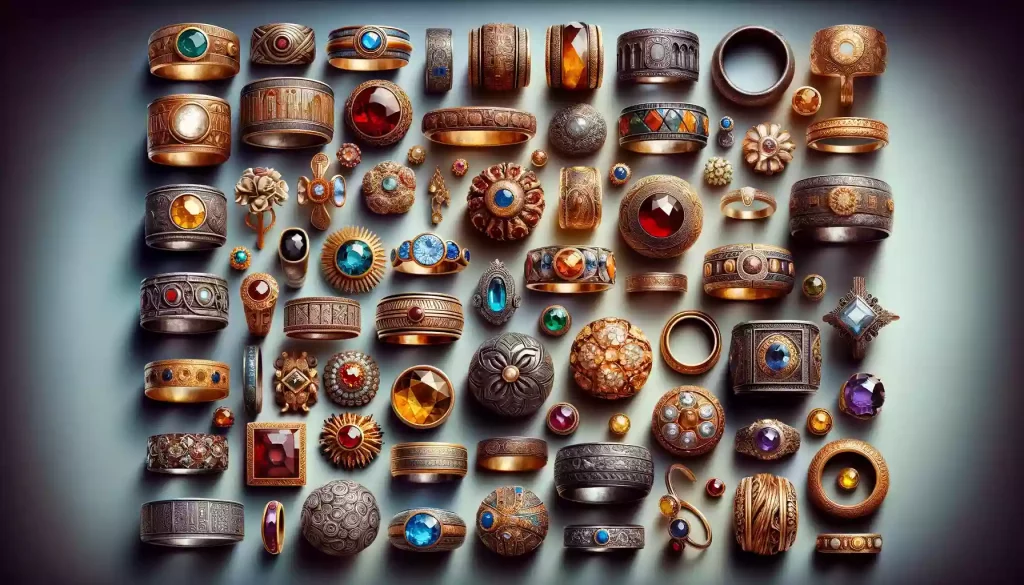
The tradition of wedding rings dates back thousands of years, traversing vast cultures and histories. Initially, these rings were more than mere ornaments; they symbolized agreements, signified wealth, or even, in some cases, indicated a form of 'payment' for the bride. The materials and designs of these early rings varied significantly depending on the culture and era, reflecting the societal values and aesthetics of their times.
In ancient Egypt, for instance, wedding rings were made of braided hemp or reeds, symbolizing eternal love and life, as the circle has no beginning or end. The Romans, on the other hand, adopted the use of iron rings, symbolizing strength and permanence in marriage. These rings were often engraved with symbols or inscriptions, adding a personal and spiritual dimension to the tradition.
The Christian influence in Europe brought about significant changes in wedding ring traditions during the Middle Ages. The church endorsed the use of wedding rings as a public profession of marriage and encouraged more ornate designs, often studded with gems. This era also saw the rise of the 'posy ring', engraved with romantic poems or religious verses, deepening the emotional and spiritual connection with the marriage finger tradition.
The Renaissance period further enriched wedding ring traditions, with more intricate designs and the use of precious metals like gold and silver. This period also witnessed the emergence of the diamond ring as a symbol of marriage, a trend that has continued to this day. Each era's unique approach to wedding rings reflects the evolving perspectives on love, commitment, and the marriage finger itself.
Symbolism Behind the Ring Finger
The choice of the ring finger for wedding rings is steeped in symbolism and historical beliefs. One of the most enduring reasons for its selection is the ancient Roman belief in the 'vena amoris', or 'vein of love', which was thought to run directly from the ring finger to the heart. This romantic notion, though medically inaccurate, has perpetuated the tradition of the marriage finger across cultures.
In many Eastern cultures, the ring finger is believed to represent different qualities related to marriage. For instance, in traditional Chinese philosophy, each finger is associated with a different relationship aspect, and the ring finger symbolizes the union of hearts. This cultural interpretation adds a layer of meaning to the practice of wearing wedding rings on this particular finger.
Beyond cultural beliefs, the practical aspects also play a role in the ring finger's selection. Being one of the less used fingers, it reduces the wear and tear on the ring, preserving its symbolic and aesthetic value. Additionally, the ring finger's position, nestled between the middle and little fingers, provides a balance that symbolizes the equilibrium and harmony desired in a marriage.
The ring finger is not just a bearer of jewelry; it's a canvas for expressing love and commitment. The very act of placing a ring on this finger during a wedding ceremony is a powerful symbol, representing the transition from single life to a bonded partnership. This gesture, repeated millions of times across the world, carries deep emotional resonance.
Today, the symbolism of the ring finger continues to evolve, reflecting contemporary values and ideologies. For many, it's a personal statement of their relationship's uniqueness and depth, transcending traditional interpretations and embracing a more inclusive understanding of love and commitment.
Cultural Variations in Marriage Finger Customs
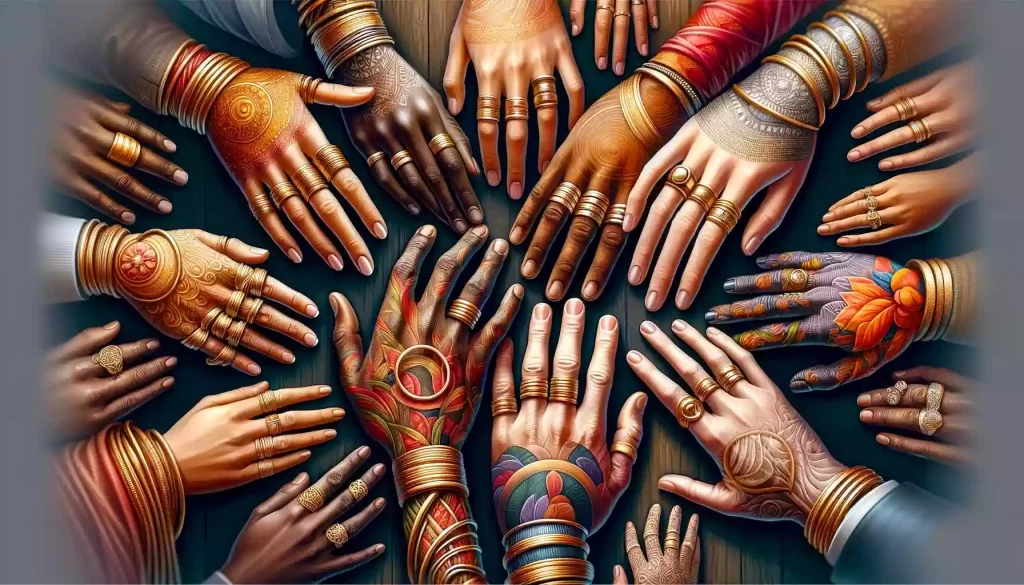
The marriage finger custom, while universal in its symbolism of love and commitment, varies significantly across cultures. This diversity offers a window into the rich tapestry of global marital traditions. In Western cultures, the left hand's fourth finger is predominantly chosen for the wedding ring, based on ancient Roman beliefs. However, this is not a universal norm.
In many Eastern European countries, such as Russia and Poland, and in countries like India, the wedding ring is traditionally worn on the right hand. This variation often stems from religious and cultural beliefs, where the right hand is considered more favorable or pure. Similarly, in Jewish tradition, the wedding ring is initially placed on the right index finger during the ceremony, although many switch it to the left hand afterward.
In some cultures, the material and design of the ring also carry cultural significance. For instance, in Nordic countries, simple gold bands are preferred, symbolizing simplicity and equality in the relationship. In contrast, elaborate designs and precious stones are more common in North American and Western European cultures, reflecting a focus on individual expression and status.
Exploring these cultural variations not only broadens our understanding of the marriage finger customs but also highlights the universal human desire to symbolize love and partnership. Despite the differences, the underlying sentiment of commitment and unity resonates across all cultures.
Choosing the Perfect Wedding Ring for Your Marriage Finger
Selecting the perfect wedding ring is a significant decision in the journey of marriage. It's not merely a piece of jewelry; it's a symbol of your love and commitment. When choosing a ring for your marriage finger, consider both style and substance. The design should resonate with your personal aesthetics and the material should be durable enough to withstand daily wear.
Comfort is key in selecting a ring, as it's something you'll wear every day. The fit should be snug but not tight, allowing for natural changes in finger size over time. The ring's width and the metal's weight are also important considerations. Some prefer a lighter, more delicate ring, while others opt for a more substantial presence.
The symbolism behind the ring is also a crucial aspect. Some couples choose matching rings to symbolize their unity, while others select individual designs that reflect their personalities. The choice of metal and stones can also carry symbolic meanings. For example, diamonds are often associated with durability and gold with purity.
Finally, think about the long-term aspects. Choose a ring that you can see yourself cherishing for many years. Whether it's a classic band or a unique custom design, ensure that it reflects the enduring nature of your commitment to each other.
The Science of Wearing Rings: Comfort and Considerations
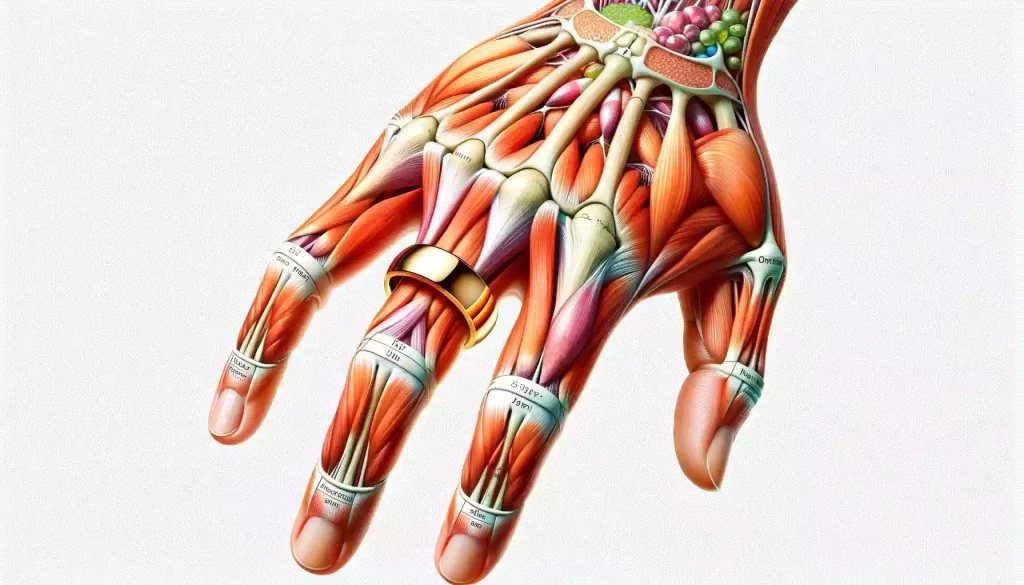
Wearing a ring, especially a wedding ring, is not just a matter of tradition or style. There's a science to it that ensures comfort and avoids potential health issues. The fit of the ring is paramount; it should be snug enough to stay on the finger but loose enough to allow for blood circulation and natural swelling that can occur throughout the day.
Material choice plays a significant role in the comfort of a ring. Metals like gold and platinum are less likely to cause allergic reactions, making them a popular choice. However, newer materials like silicone and tungsten offer alternatives for those with metal sensitivities or active lifestyles. The weight and thickness of the ring can also impact comfort, with some people preferring lighter, thinner bands.
The design of the ring is another crucial aspect. Some designs have sharp edges or protruding elements that can catch on clothing or hair. Ergonomically designed rings with smoother profiles can minimize these issues, making them more practical for everyday wear. Moreover, the finish of the ring, whether polished or matte, can affect how the ring interacts with the skin.
For those who work with their hands or engage in sports, it's important to consider the durability of the ring. Harder metals can withstand more wear and tear, but they may also be more difficult to cut off in an emergency. Silicone rings are an increasingly popular alternative for those needing a safer, more flexible option.
Finally, the size of the finger can change over time, so it's essential to have your ring resized if necessary. Weight fluctuations, temperature changes, and even certain medical conditions can affect finger size, and regularly checking the fit of your ring can prevent discomfort or loss of the ring.
How to Care for Your Marriage Finger and Ring
Caring for your marriage finger and your wedding ring is essential for both comfort and preserving the ring's beauty. Regular cleaning of the ring is crucial, especially for rings with intricate designs where dirt and grime can accumulate. Using a soft brush with mild soap and water can effectively clean most rings, though professional cleaning is recommended for more delicate or valuable pieces.
Avoiding harsh chemicals and removing your ring during activities that could damage it, such as heavy lifting or gardening, can also help maintain its condition. It's also advisable to remove your ring before swimming, as chlorine and saltwater can damage certain metals and gemstones.
Caring for your marriage finger itself is equally important. Keeping the skin hydrated and protected from extreme temperatures can prevent discomfort and skin problems. If you notice any signs of irritation or allergic reactions, it's important to address them promptly, as they can lead to more serious issues.
Finally, insuring your wedding ring is a wise decision, especially if it's valuable. Insurance can protect against loss, theft, or damage, providing peace of mind for such an important symbol of your marriage.
Trends in Marriage Finger Jewelry: What's Popular Now?
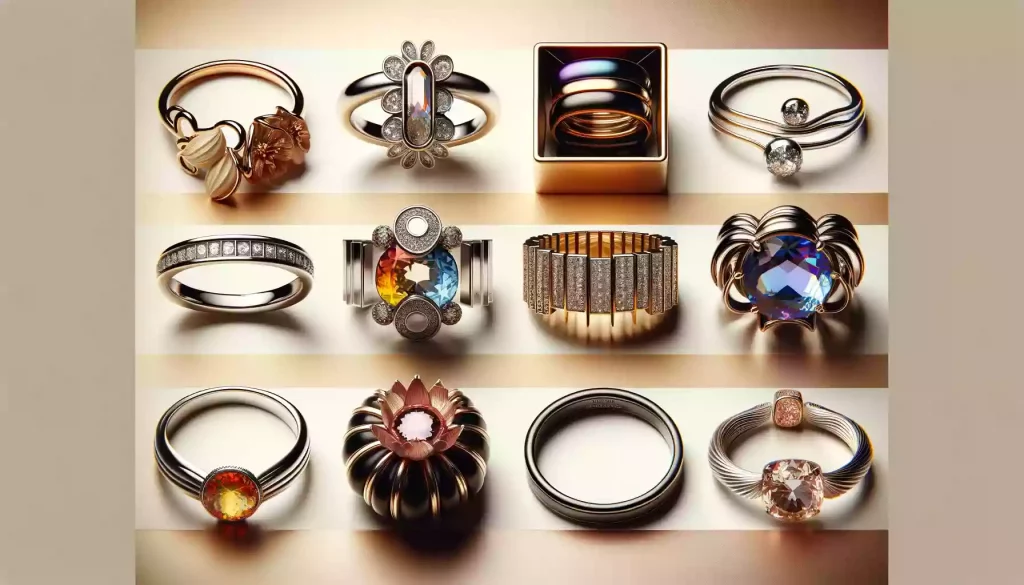
The world of marriage finger jewelry is constantly evolving, with new trends emerging that reflect contemporary tastes and lifestyles. One of the most notable trends is the shift towards minimalism. Sleek, simple bands are gaining popularity, appealing to those who prefer understated elegance. These minimalist designs often feature subtle details like small diamonds or unique textures.
On the other end of the spectrum, intricate and ornate designs are also in vogue. Rings with detailed filigree work, colorful gemstones, and unconventional shapes cater to individuals seeking a more distinctive and expressive style. These rings are often seen as a form of personal art, reflecting the wearer's personality and aesthetic preferences.
Eco-conscious and ethical jewelry choices are becoming increasingly important. Many couples now opt for rings made from recycled materials or responsibly sourced gemstones, reflecting a commitment to sustainability. This trend aligns with broader societal movements towards environmental responsibility and ethical consumption.
Technology has also left its mark on marriage finger jewelry. Custom-designed rings using 3D printing technology allow for unparalleled personalization and creativity. This trend caters to those who desire a truly unique ring that tells their individual story.
Finally, the trend of wearing non-traditional materials such as silicone, wood, or even tattooed rings is on the rise. These alternatives appeal to those who prioritize comfort, practicality, or a non-conventional approach to marriage symbolism.
The Role of the Marriage Finger in Modern Relationships
The role of the marriage finger in modern relationships extends beyond traditional symbolism. Today, it often reflects personal identity and the dynamics of the relationship. For some, wearing a ring on the marriage finger is a proud declaration of their commitment, while for others, it's a more subtle expression of their bond.
In contemporary society, the marriage finger can also represent individuality within a union. Couples are increasingly choosing rings that reflect their personal style rather than adhering to traditional designs. This shift highlights the importance of self-expression and personal identity in modern relationships.
For many couples, the marriage finger symbolizes equality and partnership. The choice of matching or complementary rings can reflect a shared journey and mutual respect. This aspect is particularly significant in a time when relationships are increasingly seen as partnerships of equals.
The significance of the marriage finger also extends to social and legal recognition. In many contexts, a ring on the marriage finger is a universally understood symbol of marital status, carrying implications in social, legal, and even financial realms.
However, it's important to note that not all modern relationships adhere to the tradition of the marriage finger. For some couples, the decision not to wear rings is a conscious choice, reflecting a belief in an unadorned, straightforward expression of love and commitment.
The marriage finger can also play a role in the rituals and ceremonies that mark significant relationship milestones. Whether it's the exchange of rings during a wedding ceremony or the gifting of an anniversary band, these moments imbue the marriage finger with deep emotional significance.
Lastly, the marriage finger in modern relationships can be a canvas for storytelling. The rings it bears often have stories behind them - be it an heirloom passed down through generations, a ring chosen together, or a piece that symbolizes a significant moment in the couple's journey. These stories add depth and richness to the tradition of the marriage finger, making it a meaningful aspect of modern relationships.
Celebrity Insights: Famous Marriage Finger Rings
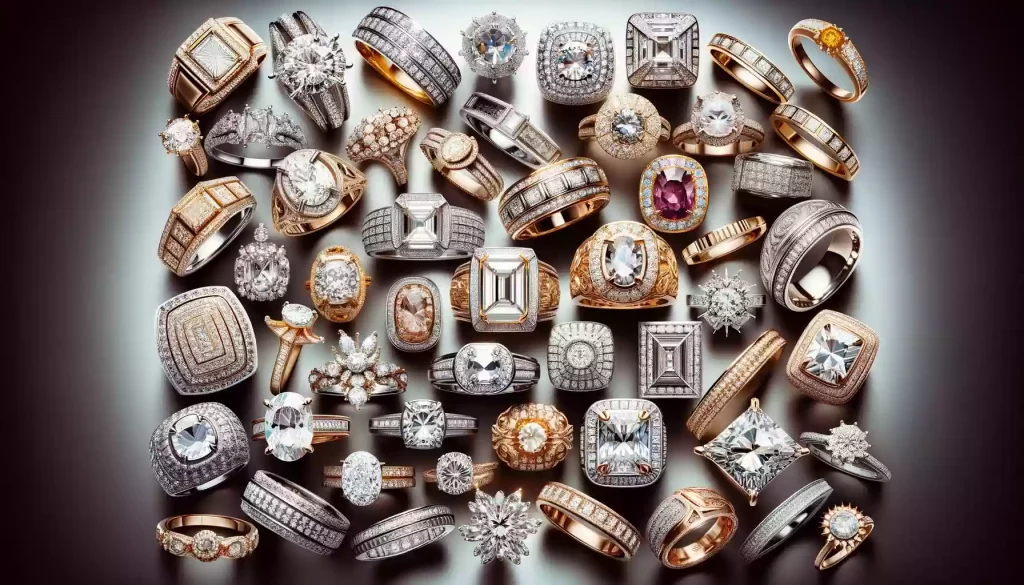
Celebrities often set trends in fashion and jewelry, and this is especially true for marriage finger rings. From extravagant diamonds to unique custom designs, celebrity wedding rings capture the public's imagination and influence trends worldwide. Some celebrities opt for massive, eye-catching stones that symbolize their status and lifestyle.
Classic elegance never goes out of style, as seen in the choices of many celebrities who prefer traditional designs with a modern twist. These rings often feature large center stones, complemented by a band of smaller diamonds, blending timelessness with contemporary flair.
Customization is a key trend among celebrity wedding rings. Personalized engravings, unique settings, and unconventional shapes allow celebrities to express their personal stories and relationships through their rings. This trend has encouraged many non-celebrities to seek more personalized ring designs.
Vintage and heirloom rings also hold a special place in the world of celebrity marriage finger jewelry. Some celebrities choose rings with a history, wearing pieces that have been passed down through generations, adding a layer of depth and continuity to their marriage symbol.
The choice of metal is another aspect where celebrities have influenced trends. While platinum and white gold remain popular, there's a growing interest in rose gold and mixed metal rings, reflecting a broader range of personal styles and preferences.
Celebrities' choices in wedding rings often reflect a balance between extravagance and personal significance. These rings are not just fashion statements but also symbols of their unique love stories, inspiring countless others in their choices of marriage finger jewelry.
Marriage Finger Rituals Around the World
Marriage finger rituals vary significantly around the world, each reflecting the unique customs and traditions of different cultures. In India, for example, the tradition of wearing a bangle called 'Mangalsutra' is significant. It symbolizes marital status and is worn along with a wedding ring. The designs and materials of Mangalsutras vary widely, reflecting regional and cultural diversity.
In some Eastern European cultures, the wedding ring is transferred from the right hand to the left hand after the wedding ceremony, symbolizing the change in marital status. This ritual underscores the importance of the marriage finger in these cultures, marking a transition in life.
In Latin American cultures, couples often exchange 'arras', or coins, during the wedding ceremony, symbolizing their commitment to sharing their life and resources. While not directly related to the marriage finger, this ritual complements the symbolism of the wedding rings and the vows exchanged.
Finally, in some Scandinavian countries, both men and women wear engagement rings, and a second ring is added at the wedding. This tradition emphasizes equality and mutual commitment, reflecting the values of these societies.
FAQs About the Marriage Finger and Wedding Rings
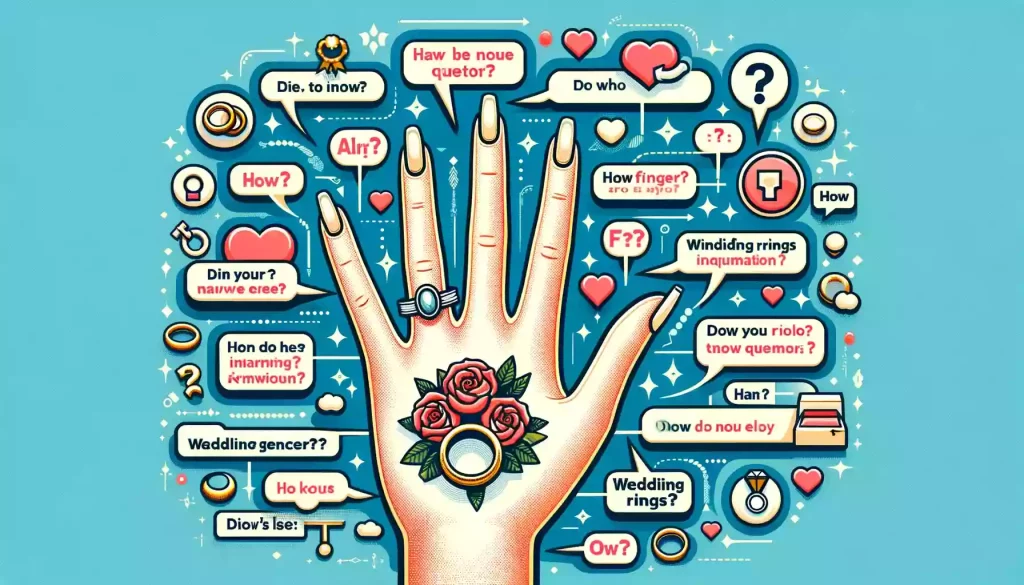
One common question is why the ring is worn on the fourth finger. As mentioned earlier, this tradition stems from the ancient Roman belief in the 'vena amoris', a vein purportedly connecting the finger to the heart. While anatomically inaccurate, this romantic notion has endured through the ages.
Another frequent inquiry is about choosing the right ring size. It's essential to measure your finger at different times of the day, as finger size can fluctuate with temperature and activity levels. Many jewelers recommend sizing your finger in the evening when it is likely to be at its largest.
People also wonder about the significance of different metals used in wedding rings. Gold, symbolizing purity and tradition, is a popular choice. Platinum, known for its durability and hypoallergenic properties, is favored for its modern appeal. Each metal brings its own symbolism and practical considerations.
There's curiosity about the cost of a wedding ring. While there's no one-size-fits-all answer, it's recommended to choose a ring that fits comfortably within your budget. The sentiment behind the ring is more important than its price tag.
Lastly, the question of wearing the ring daily often arises. This is a personal choice and depends on lifestyle and work requirements. Some people never take off their wedding rings, while others wear them only on special occasions.
Future of Marriage Finger Traditions: Predictions and Trends
Looking to the future, marriage finger traditions are likely to continue evolving. One trend we might see is an increase in customized and non-traditional rings, reflecting a growing emphasis on personal expression and individuality in relationships.
Technology will continue to play a significant role. We might witness more innovations like smart wedding rings that connect to devices or have embedded technology, symbolizing the fusion of tradition and modernity in marriage customs.
The importance of sustainability and ethical sourcing in jewelry is expected to grow. Future trends may include more eco-friendly materials and transparent supply chains, aligning with broader societal values.
Cultural fusion in marriage finger traditions could become more prevalent, reflecting the increasing diversity and global interconnectedness of societies. This fusion might manifest in the blending of different cultural symbols and styles in wedding ring designs.
The concept of the marriage finger might expand beyond traditional definitions. With changing attitudes towards marriage and relationships, we could see new forms of symbolism emerging, accommodating different types of partnerships and expressions of commitment.
Finally, the digitalization of the wedding ring market is likely to continue, with virtual try-ons, online customization, and digital ring sizing becoming more commonplace, making ring selection more accessible and tailored to individual needs.
Recommended Resources
- The Tell: The Little Clues That Reveal Big Truths about Who We Are, Matthew Hertenstein, Basic Books, 2013
- The Secret Life of Pronouns: What Our Words Say About Us, James W. Pennebaker, Bloomsbury Press, 2011
- Digit Ratio: A Pointer to Fertility, Behavior, and Health, John T. Manning, Rutgers University Press, 2002
- The Finger Book, John Manning, Faber & Faber, 2008
- Love 2.0: How Our Supreme Emotion Affects Everything We Feel, Think, Do, and Become, Barbara L. Fredrickson, Hudson Street Press, 2013


.jpg.1626fbc48c04fd9021fd315819807524.thumb.jpg.882936eb5901fa05cf31c75617acde2e.jpg)

.thumb.jpeg.44db4c04df92b9d233296a0149430b4d.jpeg)





Recommended Comments
There are no comments to display.
Create an account or sign in to comment
You need to be a member in order to leave a comment
Create an account
Sign up for a new account in our community. It's easy!
Register a new accountSign in
Already have an account? Sign in here.
Sign In Now